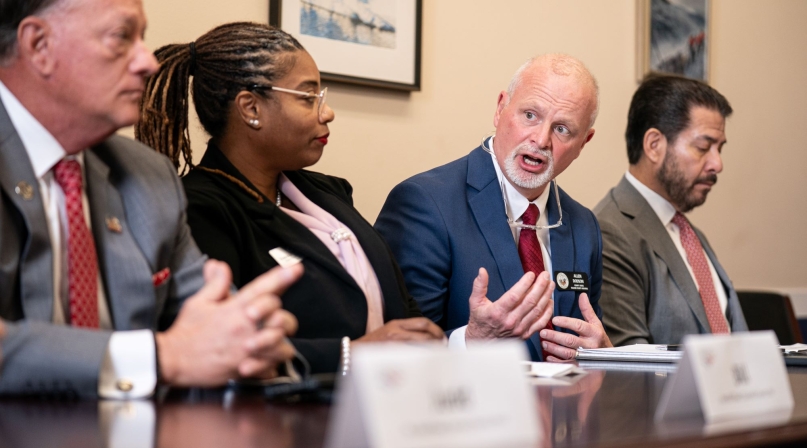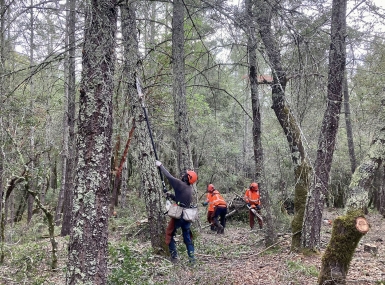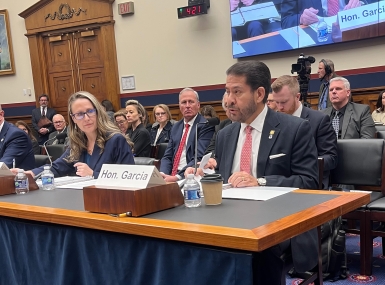Counties vie for seats on FEMA review council

When President Trump’s Federal Emergency Management Agency Review Council meets, counties want to be part of the conversation.
The group established by Trump’s January executive order is set to convene by April 24, with a report due to the president Oct. 21, and Faulkner County, Ark. Judge Allen Dodson said local governments want a seat, and he doesn’t agree, as Trump has mused, that the best course of action is to abolish the agency and have states respond to disasters. Congressional action is necessary to dismantle or significantly reorganize FEMA.
“We do not need to be a nation without FEMA, we just need reform,” Dodson said during a March 4 Capitol Hill briefing during NACo’s Legislative Conference in Washington, D.C. “It would be a mistake to undertake any reform without significant dialogue and engagement by our local government.”
Rep. Salud Carbajal (D-Calif.), who served as chair of NACo’s Energy, Environment and Land Use Steering Committee during part of his 12 years on the Santa Barbara County Board of Supervisors, concurred.
“It doesn’t matter whether you call it FEMA… whatever you want to call it, you’re still going need an agency,” he said. “The bottom line is that the function that FEMA provides is invaluable.”
The review council will include up to 20 representatives, which can then create standing subcommittees and ad hoc groups, including technical advisory groups. As end users of federal disaster relief, county officials offered their perspective and feedback on FEMA’s performance as a taste of the insight they would be able to offer to the council or subsidiary committees.
Telfair County, Ga. Commissioner Dakkia Bradshaw said that rural counties like hers don’t have the staff capacity to manage the paperwork necessary to receive full reimbursement from FEMA, and they rarely have the money necessary to put up matching funds, which she suggested reducing. By comparison, Charlotte County, Fla. has two full-time staffers for that task, given the number of hurricanes and tropical storms the Gulf Coast county faces.
“That’s all they do day in, day out,” said Commissioner Bill Truex of the staffers. “It is important for the money to flow faster so we can recover our community quicker, because we can’t start projects until we know we’ve got approval.”
Bradshaw suggested that simplifying relief applications would help rural counties like hers, and Ramsey County, Minn. Emergency Management and Homeland Security Director Judd Freed agreed.
“Often, it’s the same questions asked in different ways,” he said.
That’s one of the goals of the bipartisan Disaster Survivors Fairness Act, which Rep. Dina Titus (D-Nev.) reintroduced in February. Cosponsor Rep. Chuck Edwards (R-N.C.) has been named to the FEMA Reform Committee.
On top of the many disasters counties frequently face, Titus wants to start thinking about what extreme heat could mean for communities.
“We hit 120 degrees [in Clark County, Nev.] last July and it [the heat] comes with water problems, it comes with wildfires, so it’s not an isolated problem,” she said.
Dodson said not all states are equipped to respond to all disasters, citing Southern states’ relative inexperience with snow, and drawing emergency response expertise only from elsewhere in each state would limit expertise.
“I think if you asked any emergency manager, all 5,000 members of the international association, I’d be willing to imagine that 4,900 of them would tell you that the state can’t quite handle it,” Freed said. “Just taking FEMA and breaking it up into 50 inefficient [organizations] is not a solution.”
Freed said FEMA plays a crucial role in standardizing procedures, training and communication for emergency responders, particularly when they assist in mutual aid operations.
“When you hear of a FEMA team coming to help in other states, my fire, my cops and my public health, they’re able to go to your state and your county to help you because we all train and speak the same language,” he said.
Freed noted that local emergency management staffing is often nebulous and unartful, and most of all, inadequate. Although Ramsey County is set for 6.5 full-time employees in its Emergency Management and Homeland Security department, most of the 87 other Minnesota counties typically have one person in such a role, and often on a part-time basis.
“We all need somebody in-house who’s enough of an expert,” he said. “Being sheriff, being a firefighter, being a paramedic… does not make you an expert in emergency management. It makes you an expert in responding to emergencies, but my profession is different.
“It’s important to keep in mind that emergency management is more than just disaster recovery, it’s about prevention, preparing, planning, response.”
Truex recommended that any reform allows counties flexibility and avoids mandates on how work is done, with an eye toward preparedness.
“We should encourage people and give them opportunities to do things that will improve the resiliency of their homes,” he said.
Although the county officials brought different perspectives to the conversation, they all voiced need for more efficient reimbursements. Freed mentioned Ramsey County received its reimbursements for 2023 in February 2024.
Harris County, Texas Commissioner Adrian Garcia, co-chair of NACo’s Intergovernmental Disaster Reform Task Force, noted that his county, the third most populous in the country, enjoys funding advantages that the vast number of rural counties can barely dream of.
Truex, whose county seems regularly battered by storms, feels like his finance department is on a treadmill.
“It is important for the money to flow faster so we can recover our community quicker, because we can’t start projects until we know we’ve got approval, but in a lot of cases, you have to just jump in,” Truex said. “With Hurricane Ian, we were out $180 million, and we received $81 million as of December of 2024, and now we have Helene and Milton and we’re out another $80 million.”
Related News

FEMA halts disaster mitigation grant program
On April 4, the Federal Emergency Management Agency (FEMA) announced it will not allocate $750 million this year for the Building Resilient Infrastructure and Communities (BRIC) grant program. According to the press release, FEMA will also stop funding BRIC projects that were previously approved and are still underway.

County Countdown – March 25, 2025
Every other week, NACo's County Countdown reviews top federal policy advocacy items with an eye towards counties and the intergovernmental partnership. This week features budget reconciliation, FY 2025 funding and more.

NACo testifies on the critical role of counties in disasters
NACo Intergovernmental Disaster Reform Task Force Co-Chair and Harris County, Texas Commission Adrian Garcia testifies before the House Transportation and Infrastructure Subcommittee on Economic Development, Public Buildings and Emergency Management.
Featured Initiative
Intergovernmental Disaster Reform Task Force
As disasters intensify across the country, county governments play a crucial role on the frontlines of emergency management and recovery. With a commitment to advancing federal policies that foster collaboration between counties, federal agencies and other intergovernmental partners, the Task Force builds on years of county-led efforts to enhance disaster policies and practices, driving improved outcomes nationwide.

